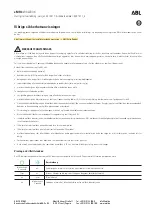
40
When the airbag inflates, they produce a
fairly loud noise and release some smoke
along with the nitrogen gas. This is not
harmful and does not indicate a fire. Be
sure to wash off any residue as soon as
possible to prevent minor skin irritation.
Deployment of the airbags happens in a
fraction of a second, so the airbags must
inflate with considerable force. While the
system is designed to reduce serious inju-
ries, it may also cause minor burns or
abrasions and swellings.
Parts of the airbag module (steering
wheel hub, dashboard) may be hot for
several minutes, but the airbags them-
selves will not be hot. The airbags are de-
signed to inflate only once.
A crash severe enough to inflate the air-
bags may break the windshield as the ve-
hicle buckles. In vehicles with a passen-
ger airbag the windshield may also be
damaged by absorbing some of the force
of the inflating airbag.
CAUTION
!
The SRS airbag system is designed
only as a supplement to the prima-
ry protection of the seat belt sys-
tems of the driver and front passen-
ger. The front seat occupants are
particularly susceptible to injury if
they do not wear their seat belts:
when sudden braking or a collision
occurs, they may be thrown for-
ward. To obtain maximum protec-
tion in an accident, the driver and
all passengers in the vehicle
should always wear their seat
belts when driving because serious
injuries can result to unrestrained
occupants. For instructions and
precautions concerning the seat
belt system, see “Seat belts” in the
chapter.
A baby or small child who is too
small to use a seat belt should be
properly secured in a rear seat us-
ing a child restraint system.
Never use a rear-facing child re-
straint system in the front seat be-
cause the force of the rapid infla-
tion of the passenger airbag can
cause severe injury to the child.
Vehicles with a passenger airbag
display a caution label on the pas-
senger side instrument panel as
shown above to remind you not to
install a rear-facing child restraint
system on the front seat.
Summary of Contents for Previa
Page 4: ......
Page 6: ...2 Instrument panel overview ...
Page 7: ...3 ...
Page 8: ...4 Instrument cluster overview ...
Page 10: ...6 ...
Page 87: ...82 ...
Page 102: ...97 Button display for radio cassette tape player compact disc player Type 3 ...
Page 127: ...122 ...
Page 145: ...140 ...
Page 157: ...152 ...
Page 175: ...170 ...
















































